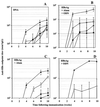CpG DNA can induce strong Th1 humoral and cell-mediated immune responses against hepatitis B surface antigen in young mice
- PMID: 9861007
- PMCID: PMC28081
- DOI: 10.1073/pnas.95.26.15553
CpG DNA can induce strong Th1 humoral and cell-mediated immune responses against hepatitis B surface antigen in young mice
Abstract
Successful neonatal immunization of humans has proven difficult. We have evaluated CpG-containing oligonucleotides as an adjuvant for immunization of young mice (1-14 days old) against hepatitis B virus surface antigen. The protein-alum-CpG formulation, like the DNA vaccine, produced seroconversion of the majority of mice immunized at 3 or 7 days of age, compared with 0-10% with the protein-alum or protein-CpG formulations. All animals, from neonates to adults, immunized with the protein-alum vaccine exhibited strong T helper (Th)2-like responses [predominantly IgG1, weak or absent cytotoxic T lymphocytes (CTL)]. Th2-type responses also were induced in young mice with protein-CpG (in 1-, 3-, and 7-day-old mice) and protein-alum-CpG (in 1- and 3-day-old mice) but immunization carried out at older ages gave mixed Th1/Th2 (Th0) responses. DNA vaccines gave Th0-like responses when administered at 1 and 7 days of age and Th1-like (predominantly IgG2a and CTL) responses with 14-day-old or adult mice. Surprisingly, the protein-alum-CpG formulation was better than the DNA vaccine for percentage of seroconversion, speed of appearance, and peak titer of the antibody response, as well as prevalence and strength of CTL. These findings may have important implications for immunization of human infants.
Figures



References
Publication types
MeSH terms
Substances
LinkOut - more resources
Full Text Sources
Other Literature Sources

